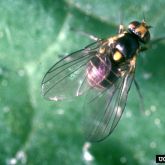Serpentine leafminer
Alert
Have you seen serpentine leafminer?
Serpentine leafminer is known to be present in South East Queensland.
If you suspect you have found serpentine leafminer in other areas of Queensland, report it to Biosecurity Queensland on 13 25 23.

Adult serpentine leafminer
Central Science Laboratory, Harpenden, British Crown, bugwood.org

Damage to onion/shallot leaves caused by larvae
Merle Shepard, Gerald R.Carner, and P.A.C Ooi, Insects and their natural enemies associated with vegetables and soybean in Southeast Asia, bugwood.org

Potato leaf damage caused by larvae
Merle Shepard, Gerald R.Carner, and P.A.C Ooi, Insects and their natural enemies associated with vegetables and soybean in Southeast Asia, bugwood.org
Serpentine leafminer (Liriomyza huidobrensis) is a small fly whose larvae feed internally on plant tissue, particularly the leaf, causing distinctive mine damage.
It poses a significant threat to Australia's agriculture and nursery industry as it is a highly polyphagous species affecting a wide range of common horticultural crops and ornamental plant species.
Infestation of plants would most likely be detected through the presence of mines in the surface of leaf tissue. Leaf mines usually appear white or pale green with black and dried brown areas. Leaf mines are typically serpentine or irregular in shape and increase in size as the larvae mature.
Cause
Serpentine leafminer (Liriomyza huidobrensis) is the larva of small flies belonging to the family Agromyzidae.
The fly larvae tunnel within leaf tissue, which is why they are called leafminers.
Other names
- pea leafminer
- South American leafminer
- Liriomyza
Description
Adults
- Small fly, 1–2.5mm.
- Black with yellow head and yellow spots on thorax.
- Brownish-yellow antennae with dark end segments.
Larvae
- Transparent when they first hatch before turning pale yellow-orange then solid yellow-orange as they mature.
- Develop inside leaf tissue and vary in size but can reach up to 3.2mm.
- Form irregular serpentine mines, which tend to be restricted by leaf veins.
Pupae
- Pupation occurs externally to the leaf usually in the soil below the plant and sometimes on the leaf surface.
- Adversely affected by high humidity or drought.
Eggs
- Slightly translucent and off-white.
- Tiny, barely visible to the naked eye.
- Laid under the leaf surface.
Plant stage and plant parts affected
Host plants of any age and stage of growth can be infested but young plants are most susceptible. Serpentine leafminer mainly affects leaf tissue.
Plant damage
Mines in the surface of leaf tissue are typically the first signs. Leaf mines are usually white or pale green, with black and dried brown areas. Leaf mines are typically serpentine or irregular in shape and increase as the larvae mature.
Mining activity by the larvae causes loss of healthy leaf tissue, affecting the plants ability to photosynthesize. The damage caused when the fly lays its eggs, or during the mining process of the larvae, can lead to diseases caused by fungi and bacteria. In severe infestations leaves can wilt and die, causing defoliation.
May be confused with
Similar damage could be caused by other leaf mining insects that are present in Queensland.
American serpentine leafminer (L. trifolii) and vegetable leafminer (L. sativae) also produce highly convoluted (squiggly) leaf mines and have a broad host range.
If you find leafminer damage on a variety of plant species at the same location, you should report it.
Distribution
Serpentine leafminer originates from Central and South America and has since spread to Africa, Asia, Europe and North America.
Serpentine leafminer was first detected in New South Wales and Queensland in November 2020.
Hosts
Serpentine leafminer affects a wide range of common horticultural crops and ornamental plant species.
They have been found to seriously affect solanaceous crops (such as potato, tomato and eggplant), as well as crops in the Asteraceae, Cucurbitaceae and Fabaceae families.
Life cycle
Several generations may be produced in a year. Female flies pierce the leaf surface to lay eggs inside. Eggs hatch in 2–5 days depending on temperature and larvae mine the leaf tissue. The larvae primarily feed on the leaf in which the eggs are laid. Larvae leave the plant to pupate.
Impacts
Serpentine leafminer damage reduces crop yield and marketability, resulting in economic losses to growers, particularly for leafy vegetables.
Home gardeners would also be affected.
How it is spread
The greatest risk of pest spread is by people moving infested plant material, soil or associated packaging.
Adult flies may also hitchhike in vehicles, machinery or aircraft.
The adult flies are not very strong flyers. The flies usually walk quickly over leaves and fly short distances to move between leaves or nearby plants. Strong winds may assist adult flies to fly further afield.
Monitoring and action
Inspect your plants regularly for the presence of leaf mines.
Look for leafminer damage on a variety of plant species or unusual or severe leafminer leaf damage.
If you suspect you have found serpentine leafminer in areas other than South East Queensland, report it to Biosecurity Queensland.
Prevention
Protect your farm from plant pests and diseases:
Control
Integrated pest management options are likely to be more effective than chemical suppression in the control of serpentine leafminer. For further information explore the resources on leafminer management and control from the AUSVEG leafminer project.
Further information
- NSW Department of Primary Industries control methods and chemical management options for leafminers.